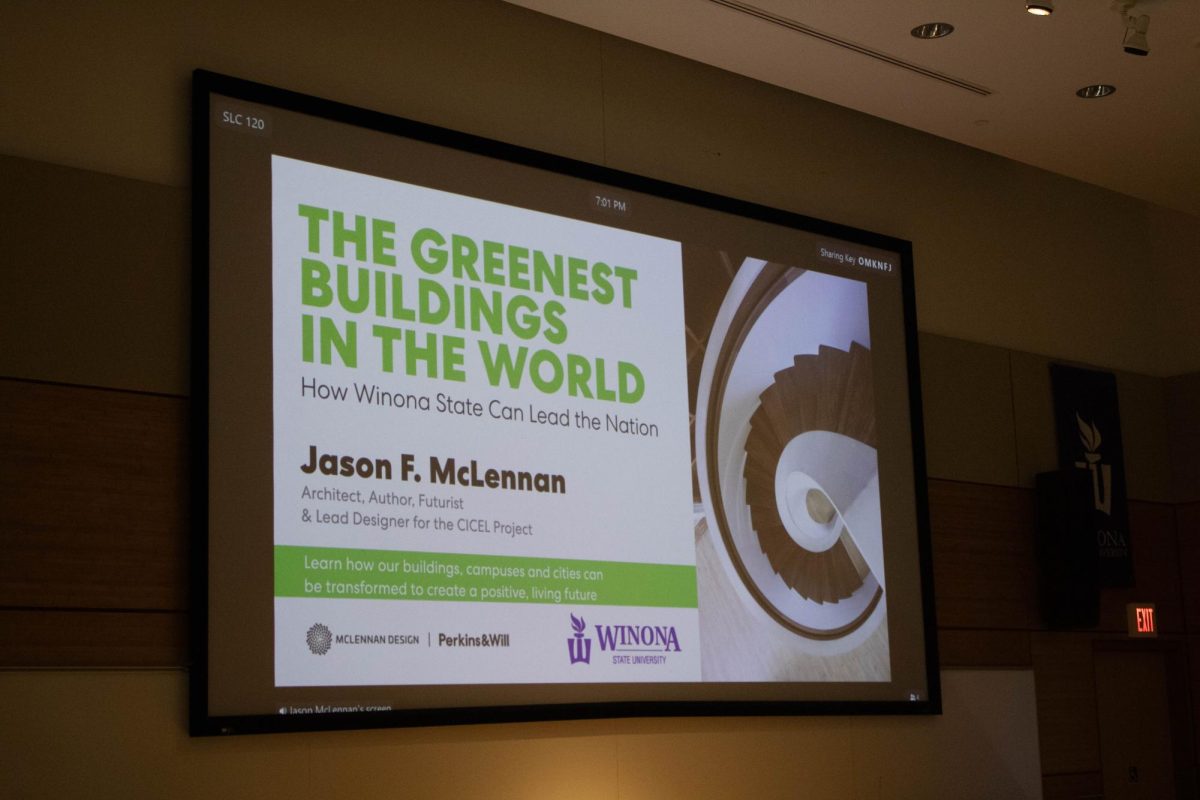What does good look like?
That is a question that the lead designer for the newest building coming to campus, Jason F. McLennon, raised in his talk on February 7th in the SLC. The talk was a chance for McLennon to show off his past and current projects as ways that the Gildemeister and Watkins replacement is heading towards, and as a chance for people to meet the design team on the project.
McLennon grew up in Sudbury, Ontario, in the 1970s which he describes as very different now than how it was as a kid. It is situated north of Lake Huron and was once home to the world’s largest smokestack. Despite all of this, McLennon was always one with nature, often finding himself canoeing, camping, being outside all the time, the works.
After, when the residents of Sudbury were finally tired of the devastation happening to their community they began to bring life back into the place. And from that spurring of life back into our planet, McLennon learned a very important lesson.
“Humanity, when it wants something from the planet, it is capable of destroying life itself. But on the other hand, when we decide to care about our communities we actually can be agents of regeneration. We can be agents of healing,” McLennon said.
This is what led him to campus, and as the lead designer of our newest building, it gave him the ability to be an agent of regeneration. But what exactly is he designing?
McLennon work is within the CICEL project, or the Center for Interdisciplinary Collaboration, Engagement, and Learning. It is a building estimated to be over $71 million, and 73,000 gross square feet (GSF), which is not only slightly smaller than Gildemeister and Watkins combined, but according to a CICEL project budget request to the state of Minnesota will remove more than $11 million in deferred maintenance and cost half as much in building operation costs.
James Goblirsch, who not only is the Assistant Vice President for Facilities Management, but is closely involved with the project described that a life-cycle cost analysis (LCA) was done to determine whether replacement of Gildemeister and Watkins or rebuilding would be most cost-efficient. The LCA, which takes construction costs, alongside operating and maintenance costs for 50 years, was done to determine which plan of action would be most cost-effective. It was determined that a replacement would be necessary.
The CICEL project is set to be a step to reaching a Winona State University 2022 Comprehensive Facilities plan of carbon neutrality of 2050. In addition to being carbon neutral, the building and site of CICEL will reduce energy, water use, along with carbon emissions, and it will be water balanced, toxic free, and low waste. This aligns with McLennon’s vision, of which he aims to, in his own words, leave a positive handprint with his buildings instead of a smaller footprint.
Along with being eco-friendly, Goblirsch explains that the main goal of CICEL is to make it accessible and equitable for everyone.
“In this spirit, the learning spaces need to support the needs of all learners now and long into the future…The building also needs to be adaptable so that learning spaces can change over time and continue to be equitable and accessible for future learners,” Goblirsch said.
With buildings described as obsolete, any change can be an improvement. While the CICEL project is in its early stages, there are no designs floating around, but campus members already have ideas for what they hope to see with the project.
Serena Rosewitt, a freshman Geoscience Major, wants a space for plants to come off the building as a way to provide an ecosystem for the animals on campus.
“I’m really hoping they add stuff for bees, in particular. And butterflies.… I remember when I was little there being so much, and that’s where I was like, do you add flowers? Because they’re already collecting water.”
On a similar note of being ecofriendly, Professor Pingping Zhang of the Mathematics and Statistics Department here at Winona State, was at first concerned about where she would be during the construction.
“I’m a professor [in Gildemeister] so I was a little concerned about where I will be when they destroy the building, but now I feel it’s totally worth it for all the energy conservation, and we’re going to be carbon positive,” Pingping Zhang said.
There are currently no concrete plans for the professors who will be displaced during the CICEL project, as the project is still in its planning phase.
“[This is] one of the many design tasks ahead of us,” Goblirsch said.
The CICEL project is set to begin construction in August of next year and have substantial completion by September of 2027.
If students wish to take part in designing the CICEL building and be an “Agent of Regeneration” while doing so, workshops are scheduled March 13th and 14th, and April 8th and 9th. There will be further opportunities to contribute.
































